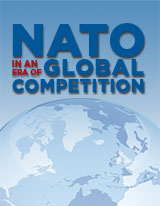Fabrice Pothier Proposes a New Posture for NATO in an Era of Global Competition
The arch of crisis from West Africa, through the Sahel, and across the Middle East to Central Asia is broadening and intensifying daily, according to a senior NATO official. Overlapping this arch of crisis is an arch of “unstable deterrence,” as countries from the Middle East to East Asia hold weapons of mass destruction and missile technology but have no rules to manage the risks associated with such capabilities.
“We have been talking about it for years, but multi-polarity is now here and it is ‘full-blown,'” said Fabrice Pothier, the head of policy planning in the Office of the Secretary General at NATO Headquarters.
Speaking to an audience at the Atlantic Council’s June 25 conference on NATO in an Era of Global Competition, Pothier explained that multi-polarity sets off “not a race to make the world unipolar or bipolar, but (…) a race to make the multipolar world [stick] to one framework, an open, rule-based system.” US-China relations and tensions in the Euro-Atlantic region due to Russia’s actions in Ukraine both manifest this new reality.
Pothier considered NATO’s current strategic concept “on target” to address immediate strategic challenges, and he expressed confidence in NATO’s capacity to rebalance from 12 years of large-scale stabilization efforts to a renewed focused on collective defense. Looking to the upcoming NATO summit in Wales this September, Pothier hopes NATO heads of state will agree on an Alliance Readiness Action Plan, which would underscore that NATO is not a one-dimensional alliance, but rather an alliance ready for strategic surprises from the east, north, and south.
Pothier’s confidence in NATO’s near-term strategic viability does not let the Alliance off-the-hook for improving its strategic posture. For the Alliance to remain a leader in the long-term race for global order, Pothier proposed a new posture of ‘Strategic Flexibility.’ This posture requires NATO to
- Never become a one-flank alliance. NATO must have the ability to confront strategic challenges not only from the north, south, and east, but also in new domains like cyber.
- Dispose of the on/off switch. Rather than choosing between large-scale, high-intensity missions or refusing to discuss certain challenges, NATO needs a more gradient approach, one that bolsters the Alliance’s political tools and gain situational awareness through consultations, but not always act.
- Develop a fuller spectrum responses. The Alliance must complement its ability to engage in high-intensity missions with modern, forward-looking deterrence and a variety of crisis management approaches.
Pothier asserted that ‘Strategic Flexibility’ requires NATO to “broaden its toolbox, but not just be a tool box.” In order to do this, Pothier saw the need for NATO members to show commitment to the benchmark of spending 2% of GDP on defense, while also prioritizing collective investment on force multipliers such as joint intelligence, surveillance, and reconnaissance. The Alliance must also engage in diplomatic and political work to find political solutions to problems that do not require military solutions.
‘Strategic Flexibility,’ according to Pothier, will allow the Alliance to help others help themselves while projecting stability, not force, around the world.

